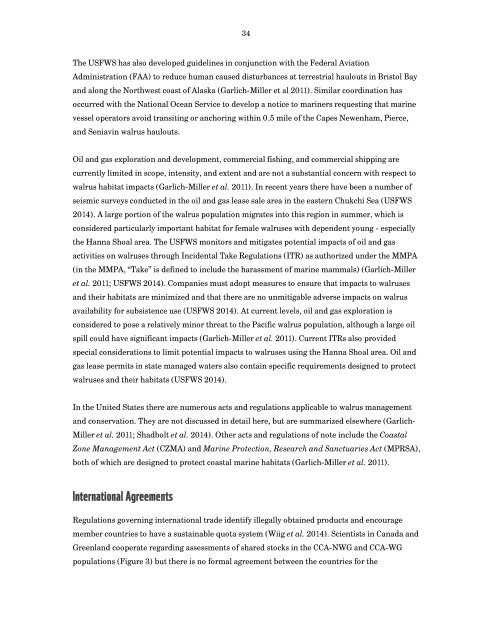The State of Circumpolar Walrus Populations
walrusreport
walrusreport
You also want an ePaper? Increase the reach of your titles
YUMPU automatically turns print PDFs into web optimized ePapers that Google loves.
34<br />
<strong>The</strong> USFWS has also developed guidelines in conjunction with the Federal Aviation<br />
Administration (FAA) to reduce human caused disturbances at terrestrial haulouts in Bristol Bay<br />
and along the Northwest coast <strong>of</strong> Alaska (Garlich-Miller et al 2011). Similar coordination has<br />
occurred with the National Ocean Service to develop a notice to mariners requesting that marine<br />
vessel operators avoid transiting or anchoring within 0.5 mile <strong>of</strong> the Capes Newenham, Pierce,<br />
and Seniavin walrus haulouts.<br />
Oil and gas exploration and development, commercial fishing, and commercial shipping are<br />
currently limited in scope, intensity, and extent and are not a substantial concern with respect to<br />
walrus habitat impacts (Garlich-Miller et al. 2011). In recent years there have been a number <strong>of</strong><br />
seismic surveys conducted in the oil and gas lease sale area in the eastern Chukchi Sea (USFWS<br />
2014). A large portion <strong>of</strong> the walrus population migrates into this region in summer, which is<br />
considered particularly important habitat for female walruses with dependent young - especially<br />
the Hanna Shoal area. <strong>The</strong> USFWS monitors and mitigates potential impacts <strong>of</strong> oil and gas<br />
activities on walruses through Incidental Take Regulations (ITR) as authorized under the MMPA<br />
(in the MMPA, “Take” is defined to include the harassment <strong>of</strong> marine mammals) (Garlich-Miller<br />
et al. 2011; USFWS 2014). Companies must adopt measures to ensure that impacts to walruses<br />
and their habitats are minimized and that there are no unmitigable adverse impacts on walrus<br />
availability for subsistence use (USFWS 2014). At current levels, oil and gas exploration is<br />
considered to pose a relatively minor threat to the Pacific walrus population, although a large oil<br />
spill could have significant impacts (Garlich-Miller et al. 2011). Current ITRs also provided<br />
special considerations to limit potential impacts to walruses using the Hanna Shoal area. Oil and<br />
gas lease permits in state managed waters also contain specific requirements designed to protect<br />
walruses and their habitats (USFWS 2014).<br />
In the United <strong>State</strong>s there are numerous acts and regulations applicable to walrus management<br />
and conservation. <strong>The</strong>y are not discussed in detail here, but are summarized elsewhere (Garlich-<br />
Miller et al. 2011; Shadbolt et al. 2014). Other acts and regulations <strong>of</strong> note include the Coastal<br />
Zone Management Act (CZMA) and Marine Protection, Research and Sanctuaries Act (MPRSA),<br />
both <strong>of</strong> which are designed to protect coastal marine habitats (Garlich-Miller et al. 2011).<br />
International Agreements<br />
Regulations governing international trade identify illegally obtained products and encourage<br />
member countries to have a sustainable quota system (Wiig et al. 2014). Scientists in Canada and<br />
Greenland cooperate regarding assessments <strong>of</strong> shared stocks in the CCA-NWG and CCA-WG<br />
populations (Figure 3) but there is no formal agreement between the countries for the


